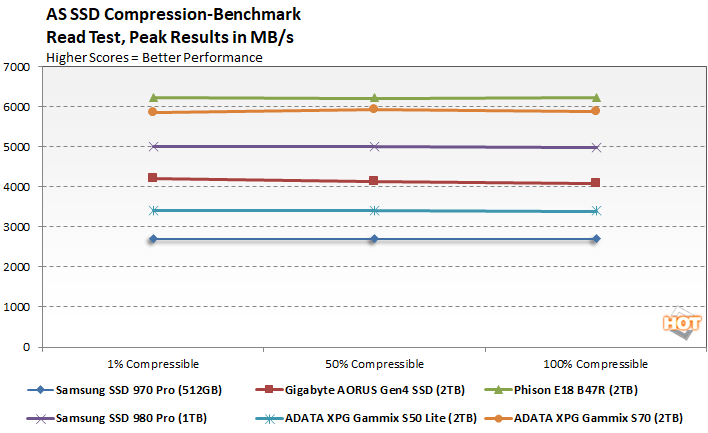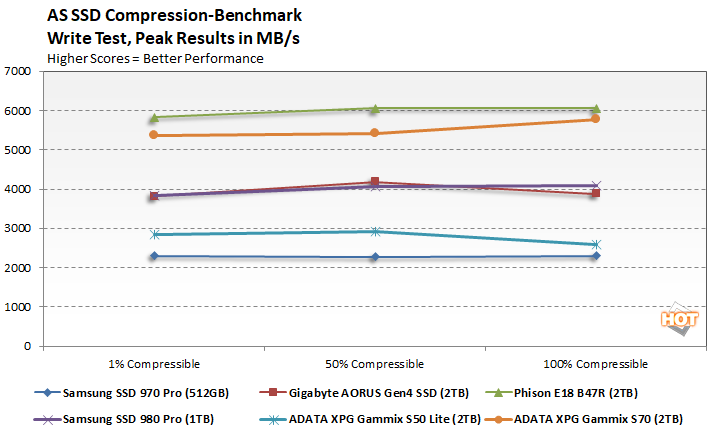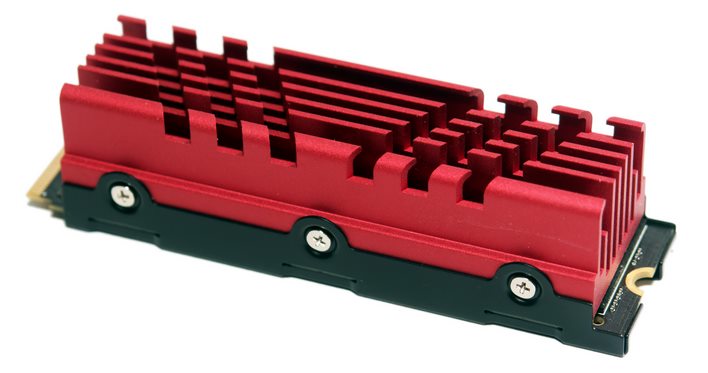Phison E18 With Micron B47R Preview: Future Of PCIe 4 SSDs
Phison E18 with Micron B47R Media: Ultra-Fast, Premium, PCIe 4.0 Storage
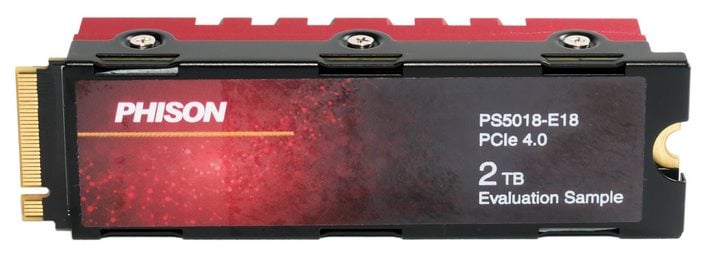
Phison E18-based drives are already shipping from a number or partners, like Corsair and Sabrent, for example. However, the drives currently on the market feature Micron B27B 96-Layer 3D TLC NAND flash memory operating at up to 1200 MT/s. The Phison E18 can support even faster NAND though, which brings us to the development vehicle we’ll be showing here. The next wave of Phison E18 based drives will feature Micron’s latest B47R 176-Layer 3D TLC NAND operating at speeds up to 1600 MT/s. Micron’s B47R features the company’s second-generation Floating Gate technology, and offers up to 35% faster read and write latency in comparison to its older high-volume, floating-gate 96-layer NAND. And versus 128-layer replacement-gate NAND, read and write latency are improved by over 25%.
Phison set us up with an E18 development drive, packing 2TB of Micron’s B47R NAND Flash, to give you all a glimpse at what some next-gen solid state drives will be able to do. So, without further delay, let’s get right to it...
|
- 3x Arm Cortex R5 + 2x Phison Proprietary IP CoXProcessor (5 Total Cores)
- 8-Channel Design with 32CE
- NVMe 1.4
- TSMC 12nm Manufacturing Process
- 4th Generation LDPC Engine
- Up to 8TB
- PCIe 4.0 x4L
- Up to 1,600MT/s NAND Bus Speed Support
- DDR4 Support
- End-to-end Data Path Protection
- SmartECC
- Hardware AES (AES 128/256 bit), SHA (160/256/512)
- RSA 4096
- TCG & Opal 2.0, Pyrite Encryption
- Crypto Erase Support
The Phison E18’s main specifications and features are listed above. Its native PCIe Gen 4, 8-channel controller is manufactured on TSMC’s 12nm node and features a trio of Arm Cortex R5 processors in conjunction with a pair of proprietary Phison CoXProcessors, for five total cores. It supports capacities up to 8TB and End-to-end Data Path Protection, Smart ECC with Phison’s 4th Generation LDPC Engine, and Hardware AES (AES 128/256 bit), SHA (160/256/512), and RSA 4096 with full support for TCG Opal 2.0 and Pyrite encryption. Peak transfer rates are expected to be in the 7.4GB/s range -- give or take.
The physical drive we received uses the common M.2 2280 form factor and was adorned with a large heatsink. Reps from Phison note, however, that the heatsink is not an absolute necessity. Throughout testing, it did get warm to the touch but we never saw internal temperatures (as reported by CrystalDiskInfo) exceed 65°C.
The thermal pads on the heatsink did a number on the markings on the various chips populating the PCB. If things were easier to read, what you’d see are eight pieces of Micron B47R 176-Layer 3D TLC NAND operating at 1600 MT/s (this is a 2TB drive), along with the Phison E18 controller and a couple of pieces of SK Hynix DDR4 RAM. This type of configuration is what we’re likely to see on next-gen, high-end, enthusiast-class SSDs. The B47R media on this drive will be available in two grades: media grade and Fortis. This drives uses Fortis grade media, which is the higher performing of the two and most likely to be used on premium E18 SSDs moving forward.
Before we get to any benchmarks, we should note that this drive features pre-production firmware and may not be indicative of retail-ready product. That said, this is one of the first, fully-working / bootable firmware revisions, and Phison expects performance to improve when drives hit retail.
Phison E18 SSD With Micron B47R Benchmarks
Under each test condition, the SSDs showcased here were installed as secondary volumes in our testbed, with a separate drive used for the OS and benchmark installations. Our testbed's motherboard was updated with the latest BIOS available at the time of publication and Windows was fully updated. Windows firewall, automatic updates, and screen savers were all disabled before testing and Windows 10 Quiet Hours / Focus Assist was enabled to prevent any interuptions.

|
| Processor - Motherboard - Video Card - Memory - Audio - Storage - |
AMD Threadripper 3990X MSI TRX40 Creator (TRX40 Chipset) GeForce RTX 2080 Ti 32GB G.SKILL DDR4-3200 Integrated on board Corsair MP600 (OS Drive) Samsung SSD 980 Pro (1TB) Gigabyte Aorus NVMe PCIe 4 (2TB) Samsung SSD 970 Pro (512GB) ADATA XPG GAMMIX S70 (2TB) Phison E18 w/ B47R (2TB) |
OS - Chipset Drivers - DirectX - Benchmarks - |
Windows 10 Pro x64 AMD v2.07.14.327 DirectX 12 IOMeter HD Tune v5.75 ATTO v4.01.0f AS SSD CrystalDiskMark v7 x64 PCMark 10 Quick Storage Bench SiSoftware SANDRA |
|
In the following tables, we're showing two sets of access patterns; a custom Workstation pattern, with an 8K transfer size, consisting of 80% reads (20% writes) and 80% random (20% sequential) access and a 4K access pattern with a 4K transfer size, comprised of 67% reads (33% writes) and 100% random access. Queue depths from 1 to 32 were tested...
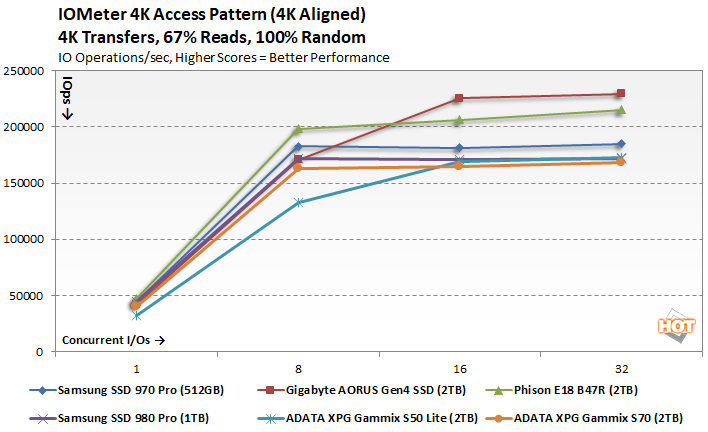
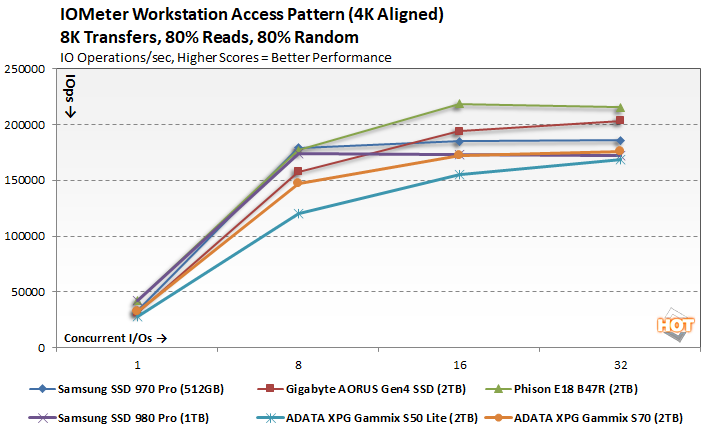
With the fully random 4K access pattern, the Phison E18-based drive led the pack up to QD8, at which point the E16-based Gigabyte drive slipped into the pole position. With the 8K access pattern, which works on sequentials into the mix, the E18 effectively led the pack -- thing were tight at QD1 and QD8, but the E18 pulled ahead at the highest queue depths.
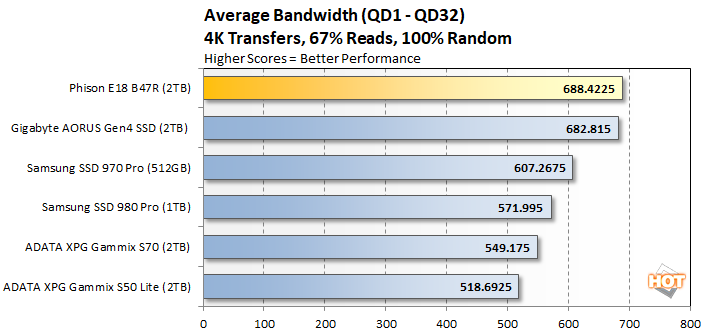
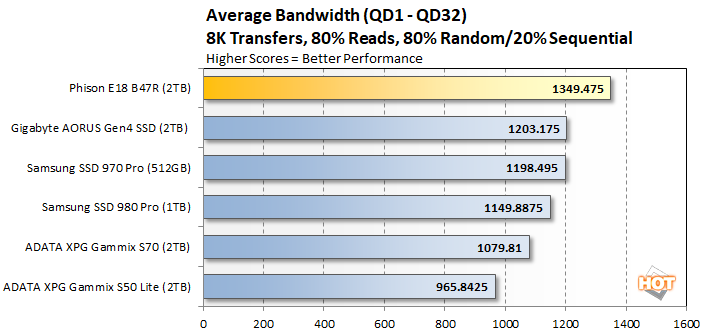
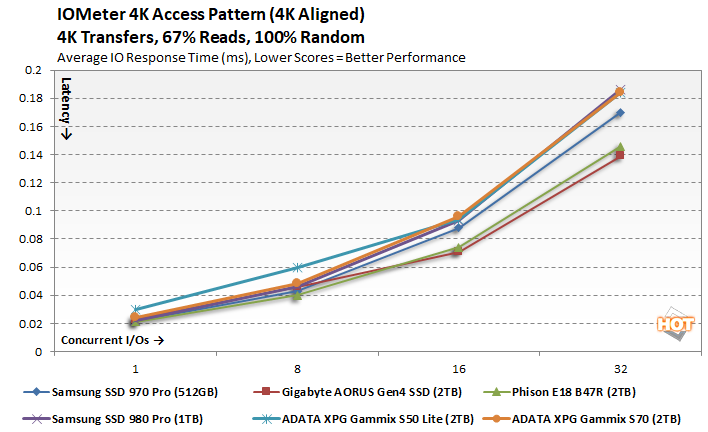
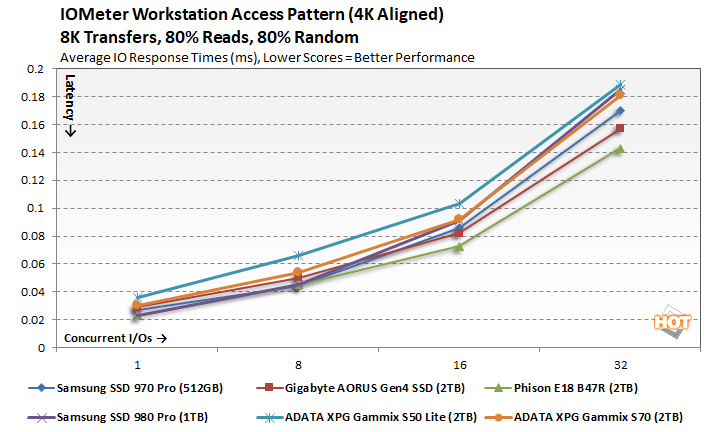
The Phison E18 with Micron B47R also offered excellent latency characteristics. At the lower queue depths with the 4K access pattern (which are the most important for consumer workloads), the E18 had the lowest latency. And with the 8K access pattern, the E18 with B47R led across the board.
|

The Phison E18 with Micron B47R outpaced all of the other drives we tested, across the board in this test. Reads, and especially writes, were significantly faster than any of the other drives we had on hand.
|
ATTO is another "quick and dirty" type of disk benchmark that measures transfer speeds across a specific volume length. It measures raw transfer rates for both reads and writes and graphs them out in an easily interpreted chart. We chose .5KB through 64MB transfer sizes and a queue depth of 6 over a total max volume length of 256MB. ATTO's workloads are sequential in nature and measure raw bandwidth, rather than I/O response time, access latency, etc.
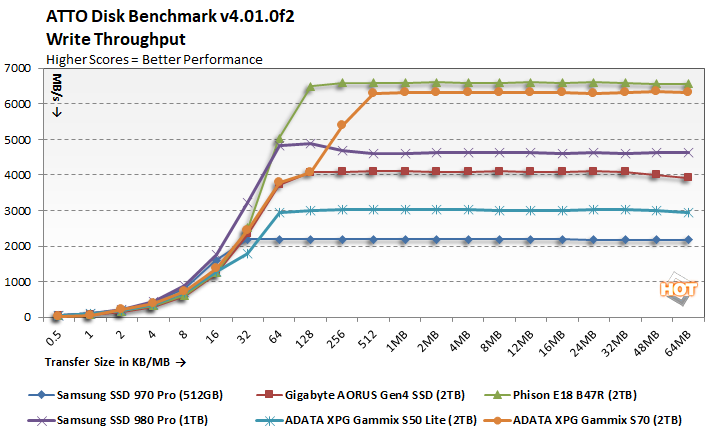
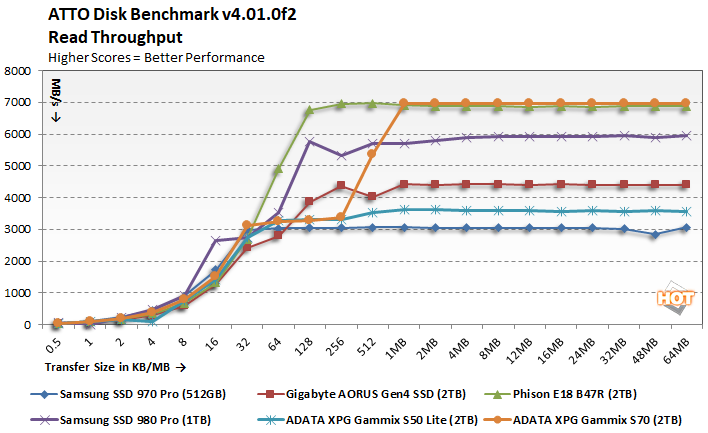
The ADATA XPG GAMMIX S70, which is built around the 8-channel InnoGrit IG5236 controller and 96-layer Micron NAND, offered ever so slightly better reads with the largest transfer sizes in ATTO, but other than that section, the Phison E18 with Micron B47R outpaced all of the other drives with the larger transfer sizes. With the smallest transfers, all of the drives are tightly grouped until about the 32K mark, where Phison begins to pull away.
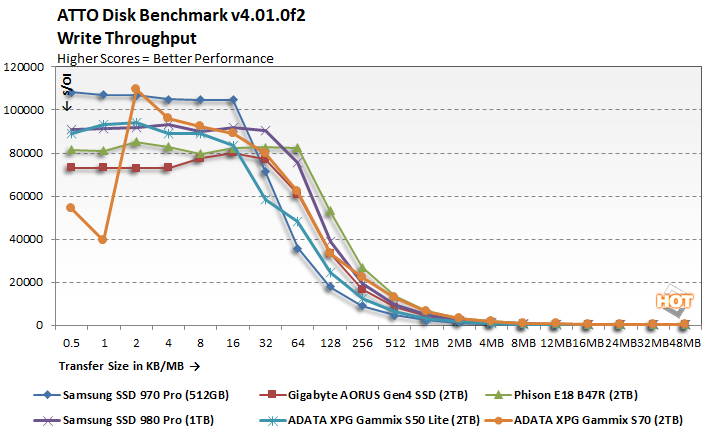
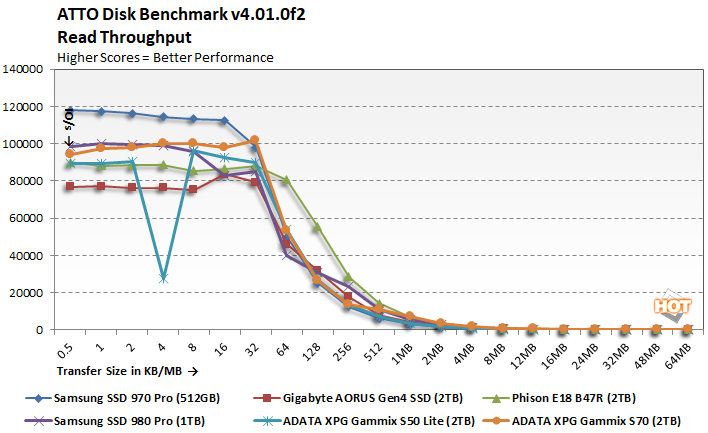
IO performance according to ATTO had the Phison E18 with Micron B47R finishing about in the middle of the pack, save for a stretch between 32K and 1MB where it led the pack.
|
Next up we ran the Compression Benchmark built-into AS SSD, an SSD specific benchmark being developed by Alex Intelligent Software. This test is interesting because it uses a mix of compressible and non-compressible data and outputs both Read and Write throughput of the drive. We only graphed a small fraction of the data (1% compressible, 50% compressible, and 100% compressible), but the trend is representative of the benchmark’s complete results.
